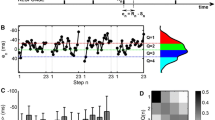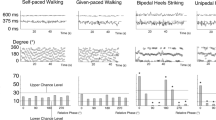Abstract
A subject lacking proprioceptive and tactile sensibility below the neck and a group of control subjects performed sequences of periodic finger taps involving a pattern of accentuation. The required intertap interval was 700 ms. In some situations, the taps were synchronized with the clicks of a metronome. Feedback conditions were manipulated by either allowing or not allowing the subjects to hear the taps and see their finger movements. We recorded the trajectory of the subjects' finger displacement in the vertical plane, and the force and moment of contact of the finger with the response key. The control subjects achieved precise timing of the finger taps by trading off downstroke onset for movement duration, e.g., they initiated shorter-duration tapping movements with a delay. This strategy did not vary depending on task demands (e.g., synchronization) or feedback conditions. The deafferented patient produced intertap intervals on average close to the required value. However, his tap timing was characterized by increased variability and severe distortion (lengthening) after the accentuated tap, regardless of feedback conditions. He did not manifest the compensatory strategy whereby, in control subjects, movement onset was adjusted to movement duration. Thus, such a strategy in controls seems to depend on intact proprioceptive and/or tactile information from the moving limb. Upon withdrawal of visual and acoustic feedback, the deafferented subject increased the force of the taps and the amplitude of tapping movements; his mean synchronization error with the metronome also increased. However, he did not lose correct phasing between the taps and the clicks of the metronome. These findings suggest that, under normal circumstances, sequential movements are timed by an internal timekeeper which paces sensory consequences relating to the occurrence of behaviorally important events (e.g., finger taps), and not the onset of the movements eliciting those events. In the synchronization task, the timekeeper may be phase locked to the periodic acoustic stimuli by direct entrainment. Feedback information may be needed, however, for keeping any synchronization error as small as possible.
Similar content being viewed by others
References
Aschersleben G, Prinz W (1995) Synchronizing actions with events: the role of sensory information. Percept Psychophys 57:305–317
Baker JR, Bremner FD, Cole JD, Stephens JA (1988) Short-term synchronization of intrinsic hand muscle motor units in a “deafferented” man. J Physiol (Lond) 396: 155P
Billon M, Semjen A (1995) The timing effects of accent production in synchronization and continuation tasks performed by musicians and nonmusicians. Psychol Res 58:206–217
Billon M, Semjen A, Stelmach GE (1996) The timing effects of accent production in periodic finger-tapping sequences. J Mot Behav (in press)
Bossom J (1974) Movement without proprioception. Brain Res 71:285–296
Church RM (1984) Properties of the internal clock. In: Gibbon J, Allan L (eds) Timing and time perception. Ann NY Acad Sci 42:566–581
Cole JD, Katifi HA (1991) Evoked potentials in a subject with a large fibre peripheral neuropathy. Electroencephalogr Clin Neurophysiol 80:103–107
Cole JD, Sedgwick EM (1992) The perceptions of force and of movement in a man without large myelinated sensory afferents below the neck. J Physiol (Lond) 449:503–515
Fraisse P (1980) Les synchronisations sensorimotrices au rythme. In: Requin J (ed) Anticipation et comportement. CNRS, Paris, pp 233–257
Fraisse P, Voillaume C (1971) Les repères du sujet dans la synchronisation et dans la pseudo-synchronisation. Ann Psychol 71:359–369
Hary D, Moore GP (1985) Temporal tracking and synchronization strategies. Hum Neurobiol 4:73–76
Hary D, Moore GP (1987) Synchronizing human movement with an external clock source. Biol Cybern 56:305–311
Kugler PN, Turvey MT (1987) Information, natural law, and selfassembly of rhythmic movement. Erlbaum, Hillsdale, NJ
Large EW, Koler JF (1994) Resonance and the perception of meter. Connection Sci 6:177–208
Mates J (1994a) A model of synchronization of motor acts to a stimulus sequence. I. Timing and error corrections. Biol Cybern 70:463–473
Mates J (1994b) A model of synchronization of motor acts to a stimulus sequence. II. Stability analysis, error estimation and simulations. Biol Cybern 70:475–484
Mott FW, Sherrington CS (1895) Experiment upon the influence of sensory nerves upon movement and nutrition of the limbs. Proc R Soc Lond B 57:481–488
Rothwell JC, Traub MM, Day BL, Obeso JA, Thomas PK, Marsden CD (1982) Manual motor performance in a deafferented man. Brain 105:515–542
Schulze HH (1992) The error correction model for the tracking of a random metronome: statistical properties and an empirical test. In: Macar F, Pouthas V, Friedman WJ (eds) Time, action and cognition: towards bridging the gap, Kluwer, Boston, pp 275–286
Shaffer LH (1982) Rhythm and timing in skill. Psychol Rev 89:109–122
Sternberg S, Knoll RL, Zukofsky P (1982) Timing by skilled musicians. In: Deutsch D (ed) The psychology of music. Academic Press, New York, pp 181–239
Treisman M, Faulkner A, Naish PLN, Brogan D (1990) The internal clock: evidence for a temporal oscillator underlying time perception with some estimates of its characteristic frequency. Perception 19:705–743
Treisman M, Faulkner A, Naish PLN (1992) On the relation between time perception and the timing of motor action: evidence for a temporal oscillator controlling the timing of movement. Q J Exp Psychol [A] 45:235–263
Voillaume C (1971) Modèles pour l'étude de la régulation de mouvements cadencés. Ann Psychol 71:347–358
Vorberg D, Wing AM (1996) Modeling variability and dependence in timing. In: Heuer H, Keele SW (eds) Motor skills. Handbook of perception and action, vol III. Academic Press, London (in press)
Wing AM (1977) Perturbations of auditory feedback delay and the timing of movement. J Exp Psychol Hum Percept Perform 3:175–186
Wing AM (1980) The long and short of timing in response sequences. In: Stelmach GE, Requin J (eds) Tutorials in motor behavior. North-Holland, Amsterdam, pp 469–486
Wing AM, Kristofferson AB (1973) Response delays and the timing of discrete motor responses. Percept Psychophys 14:5–12
Author information
Authors and Affiliations
Rights and permissions
About this article
Cite this article
Billon, M., Semjen, A., Cole, J. et al. The role of sensory information in the production of periodic finger-tapping sequences. Exp Brain Res 110, 117–130 (1996). https://doi.org/10.1007/BF00241381
Received:
Accepted:
Issue Date:
DOI: https://doi.org/10.1007/BF00241381




